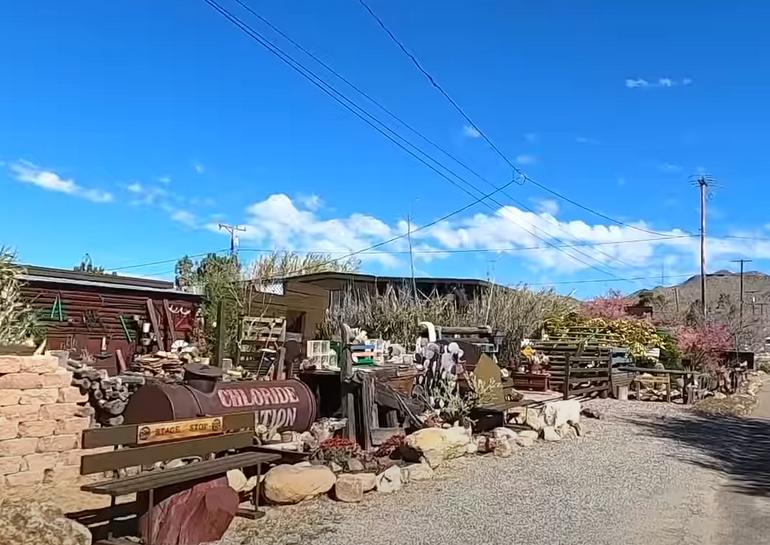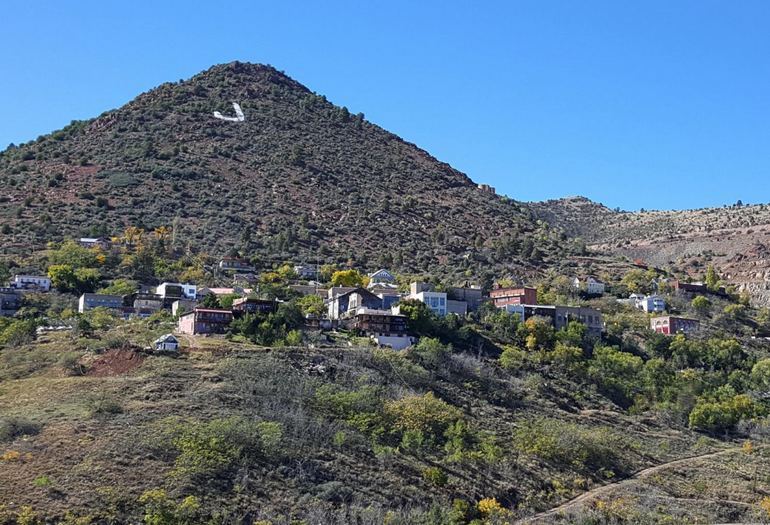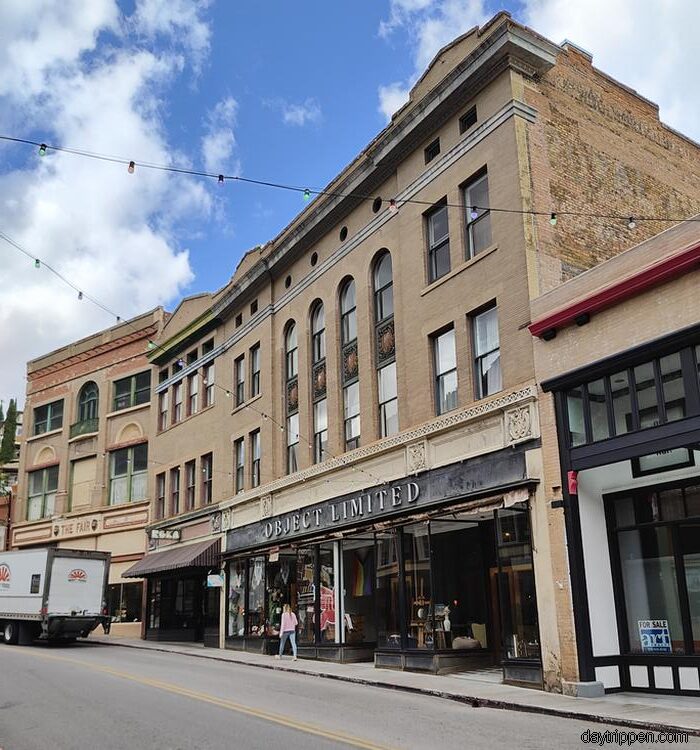- Like
- X
- Digg
- Tumblr
- VKontakte
- Buffer
- Love This
- Odnoklassniki
- Meneame
- Blogger
- Amazon
- Yahoo Mail
- Gmail
- AOL
- Newsvine
- HackerNews
- Evernote
- MySpace
- Mail.ru
- Viadeo
- Line
- Comments
- SMS
- Viber
- Telegram
- Subscribe
- Facebook Messenger
- Kakao
- LiveJournal
- Yammer
- Edgar
- Fintel
- Mix
- Instapaper
- Copy Link

Chloride, Arizona, is about a 30-minute drive from Kingman, Arizona. The town’s name comes from the silver chloride in the nearby hills. The town has a population of around 250 full-time residents, significantly fewer than the 2000-plus residents in the late 1800s. Founded in 1863, Chloride is Arizona’s oldest continuously inhabited mining town. Visitors to this historic mining town can explore its historic buildings, visit a recreated western village, enjoy a meal at Yesterdays, or take a short side trip to the Chloride Murals or the Chloride Cemetery.

Chloride History: The Early Silver Mining Days
Chloride was founded after the discovery of silver deposits in the area. Prospectors found abundant silver veins, sparking a significant silver rush that led to the establishment of over 75 mines in the region. The town faced various challenges, including conflicts with the Hualapai Indians. In 1870, a treaty was signed, resulting in substantial growth in the mining industry. Chloride peaked with a post office, general store, blacksmith, and several saloons serving the miners. However, the mines started to deplete around 1910, which caused the population to decline. By the mid-1940s, Chloride was little more than a ghost town.


The Railroad Arrives in Chloride
Before the railway was built, wagons were used to transport silver ore to the Colorado River and loaded onto steamers. On April 25, 1900, a railway connecting Chloride to Kingman, AZ, was completed. This railway greatly assisted in the transportation of ore and supplies to the mining communities. The locals fondly referred to the railway as “B&F” for “back and forth.” The railroad discontinued operations in 1931, and the line was officially abandoned in 1933. The train depot in Chloride can still be seen, although it’s private property. The rails are no longer present. However, you can still see the right-of-way in a few places.

Yesterdays Restaurant & Sheps Miners Inn
Yesterdays is the heart of Chloride, where locals and visitors can enjoy food, drinks, and entertainment. Yesterday’s and the adjacent Sheps Miners Inn were built in the mid-1800s as a Butterfield Stage Line stop. The restaurant serves classic American cuisine, including burgers, steaks, and sandwiches. The restaurant has a rustic, old-west feel, with wooden floors and walls adorned with historic photographs and memorabilia. Yesterdays is open for breakfast, lunch, and dinner. Breakfast at Yesterdays is included if you stay at Sheps Miners Inn.

Cyanide Springs Ghost Town, Chloride, AZ
Cyanide Springs is a tourist attraction located next to Yesterday’s Restaurant. It is designed to replicate an Old West town and includes a small museum, buildings such as the Dead Ass Saloon, a jail, and several original miners’ cabins. Cyanide Springs is part of Chloride and was constructed by locals as a replica Wild West town.

Chloride: Artsy Sculptures & Oddities
While driving around Chloride, you’ll see interesting sights in people’s yards. One of the most popular spots is the old gas station with a train track encircling it. Other noteworthy discoveries include the train depot, the old jail, the original Post Office, a steam tractor, mine carts, bottles, and various assortments of items. The Santa Fe Depot in Chloride, AZ, is located on 2nd Street behind the post office. Even though the “Chloride” sign on the building was covered when we visited the town, it’s still visible. Please note that the depot is private property.


Chloride Murals “The Journey”
Chloride, Arizona, is famous for the Chloride Murals, also known as “The Journey,” created in 1966 by artist Roy Purcell. While working as a miner near Chloride, Purcell painted the murals on a rock formation about 1.5 miles outside town. Over time, the murals have been repainted, adding vibrant colors to the original artwork. The restored murals continue to draw visitors to Chloride, providing a unique look into the town’s history and artistic legacy.
Chloride Cemetery
Chloride Cemetery is a historic graveyard that dates back to the late 1800s. The cemetery is renowned for its distinctive grave markers and memorials, many reflecting the town’s mining history—the oldest headstones in Chloride Cemetery date back to 1904. There are also several unmarked graves encircled by stones that could predate the turn of the century. The cemetery is a unique and significant part of Chloride’s history, offering a glimpse into the lives of the town’s early residents.

Getting to Chloride, Arizona
Despite its small size, Chloride retains its historic charm and is a popular destination for tourists interested in Arizona’s mining history. Getting to Chloride is easy and does not require a 4-wheel drive vehicle. If driving from Kingman, take Highway 93 north to Grasshopper Junction and turn right. If you are coming from Laughlin, take AZ 68 to Highway 93, turn left, then right at Grasshopper Junction. If you are traveling from Las Vegas, take Highway 93 south. Visit the town website.
You Might Like These Arizona Towns:

Oatman Arizona: Historic Boom Town
Oatman is a historic boom town that dates back to the 1860s. The discovery of a rich ore body in 1915 led to a gold rush that lasted for ten years. Today, the town’s economy is driven by tourism and its population of wild burros. Visitors can enjoy a taste of the Wild West, complete with wild donkeys, wooden sidewalks, staged gunfights, unique souvenir shops, and quirky annual events. Oatman Ghost Town is easily accessible from Laughlin, Nevada, or Bullhead City, Arizona, and makes for a fun day trip.

Jerome Ghost Town Northern Arizona
Jerome Ghost Town was once a prosperous mining town located halfway between Flagstaff and Phoenix. The city was built on the side of Cleopatra Hill and served as the center for the rich copper mines in the area. During its peak, Jerome had a population of 10,000 people. Today, less than 500 people call Jerome home, and the town’s main source of income is tourism.

Bisbee Arizona
Bisbee, Arizona, is a beautiful place to spend a day. Unlike most historic mining towns, Bisbee was built with stone and bricks, giving it more of an Eastern city look than a Wild West town. Many of the town’s buildings date back to the early 1900s. A visit to Bisbee, Arizona, is like stepping back in time. To fully experience this fantastic city, park your car and take a walking tour of this historic copper-mining town.
- Like
- X
- Digg
- Tumblr
- VKontakte
- Buffer
- Love This
- Odnoklassniki
- Meneame
- Blogger
- Amazon
- Yahoo Mail
- Gmail
- AOL
- Newsvine
- HackerNews
- Evernote
- MySpace
- Mail.ru
- Viadeo
- Line
- Comments
- SMS
- Viber
- Telegram
- Subscribe
- Facebook Messenger
- Kakao
- LiveJournal
- Yammer
- Edgar
- Fintel
- Mix
- Instapaper
- Copy Link